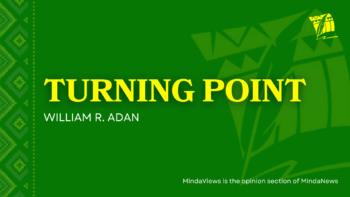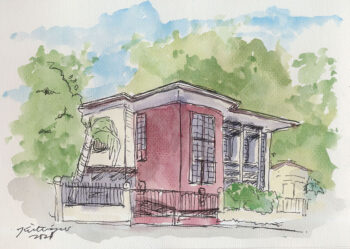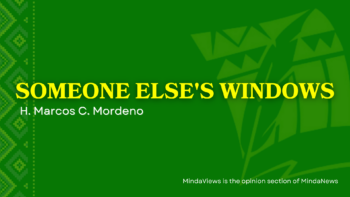DAVAO CITY (MindaNews/24 July) – A few weeks ago, just before the end of the month of June, I had a “crazy” argument with a brother in Islam. I call it crazy because he is the last person whom I think had that kind of thinking in relation to a shout out that I posted on my Facebook wall.
It took me several days to finally decide to write this response to him. I had a feeling that I might be misunderstood even further when I speak out my thoughts.
But my soul pushes me to say, “write something.” My conscience tells me that maybe it’s about time we break the silence and face whatever the consequence may come in our Muslim communities.
My shout out was about the wearing of Hijab of our Muslim women. I wrote on my Facebook wall, “hijabist and non hijabist Muslim women are Muslims. Allah judges us based on our character….”
After posting that, I am now labeled as a person who advocates or promotes the non-wearing of Hijab. I became part of the other side of the “wall” of Muslims that are called “modernist.”
My brother in Islam told me to state my basis and religious background why I said that. And if I cannot prove my point, then it’s better that I remain silent and keep my views on a personal level.
I told my brother in Islam: “this is my wall, this is my space.” I have the right to say whatever I want to say. He said, “but that is not your Islam.” Then, I really felt bad about it. At the back of my head, why is it a person whom
I respect a lot has this tendency to say that he is the holder of truth, the only truth and all the rest are false and not true?
I understand where my brother in Islam is coming from. I understand his world view as scholar and religious leader of a certain school of faith. But to impose upon me his version of Islam, then there is something wrong here. When people try to define what a Muslim is and what is not, then conflict will always arise.
Let’s define the key points: Islam is basic. It has the Holy Quran, the Hadith, and Sunnah of the Prophet (SAW). The Holy Quran is intact. The verses were revealed to Prophet Muhammad (SAW) in Arabic because that is the birth place of Islamic religion and traditions. We, Muslims, may have different interpretations on the Holy Quran, but we all agree that there are universal applications of these verses and there are specific and context based verses of the Holy Quran depending as to where and when it was revealed.
My post on Facebook was only to respect the choices of women. They can wear hijab or not. It is their character, their values and principles that matter most in dealing with their families, friends, and with their community. I respect those who wear hijab, burqa, and even niqab. But then again, their faith is not dependent upon the wearing of the veil alone.
To understand the wearing of the veil issue in Islam, let us go back to Ayat (verse) in the Holy Quran.
I have learned in my study of the Holy Quran and Hadith of the Prophet (SAW) that it is important to know the essence and the intent or the principle behind the Holy Quran and a verse that we believe revealed to our Prophet (SAW).
I strongly believe that Islam has emphasized the concept of decency and modesty in the interaction between and among people of different faith, gender, and world view. I also learned from my research and study of Islam that this is the essence of why wearing a veil was mentioned in our Holy book.
The concept of decency and modesty may vary from one faith, culture, and simply personal world view. Thus, our expression of ourselves is reflected by the way we dress. In the Holy Quran, there are two verses mentioned about the issue of decency and as most Muslims would say as the point on hijab as defined by early male dominated Muslim scholars.
Let us look at the Verse:
In Chapter 24 known as an-Nūr (the Light), in verse 30, Allah commands Prophet Muhammad as follows:
قُلْ لِلْمُؤْمِنِيْنَ يَغُضُّوْا مِنْ أَبْصَارِهِمْ وَ يَحْفَظُوْا فُرُوْجَهُمْ, ذَلِكَ أَزْكَى
لَهُمْ.
“Say to the believing men that: they should cast down their glances and guard their private parts (by being chaste). This is better for them.”
This is a command to Muslim men that they should not lustfully look at women (other than their own wives); and in order to prevent any possibility of temptation, they are required to cast their glances downwards. This is known as “hijab of the eyes”.
Then in the next verse, Allah commands the Prophet to address the women:
قُلْ لِلْمُؤْمِنَاتِ يَغْضُضْنَ مِنْ أَبْصَارِهِنَّ وَ يَحْفَظْنَ فُرُوْجَهُنَّ…
“Say to the believing women that: they should cast down their glances and guard their private parts (by being chaste)…”
This is a similar command as given to the men in the previous verse regarding “hijab of the eyes”.
According to Syed Hosein Nasr, a scholar of Islam and the Holy Quran,
“The requirement of hijab is a Qur’anic command. The basic requirement is that a Muslim woman should cover her head and bosom with a khimar (a head covering), and her body with a jilbab (a loose over-garment). Of course, she can leave her face and hands open.
When it comes to the style, colour, and material of the khimar and jilbab, each Muslim ethnic group can follow the Qur’anic injunction according to their own cultural background. The variety in styles of implementing the same Qur’anic law is so because Islam is a world religion, it cannot be confined to one region or tribe or culture. Therefore you see that the Muslim women in Arabia use ‘abaya; the Persian Muslim women use chador; the Afghani Muslim women use burqa; the Indo-Pakistani Muslim women use niqab or purdah; the Malaysian/Indonesian Muslim women use kerudung; the East African Muslim women use buibui; and now in the West, the Canadian Muslim women use mainstream clothes worn with a bigger scarf over the head and a loose outfit.”
Contrary to what most people believe, Muslim women who wear hijab are not oppressed. They are serious in their faith and we can see how the wearing of the veil evolved for several years now. We see how Muslim women make a strong statement of their sexuality and feminine side by wearing a hijab.
Again, I would like to reiterate. Muslim women should not be forced to practice their religion. The acceptance of their faith must come from their own free will and from their own hearts.
Lastly, in Suratul Hujurat (Chapter 49), verse 13, Allah (SWT) addressed mankind as a whole:
“O mankind, indeed We have created you from male and female and made you peoples and tribes that you may know one another. Indeed, the most noble of you in the sight of Allah is the most righteous of you. Indeed, Allah is Knowing and Acquainted.”
This verse is addressed to mankind. It is not limited to the Muslims alone. It also reminds us of our diversity – male and female, peoples and tribes. Thus, it considers our cultural differences. For me the most important line of this verse is the last sentence. Because of this last verse, I made that statement, “hijabist and non hijabist
Muslim women are Muslims. Allah judges us based in our character….”
(Mussolini Lidasan, an Iranun from Maguindanao, is executive director of the Al Qalam Institute for Islamic Identities and Dialogue in Southeast Asia, based at the Ateneo de Davao University where he is also pursuing his MA Anthropology)







